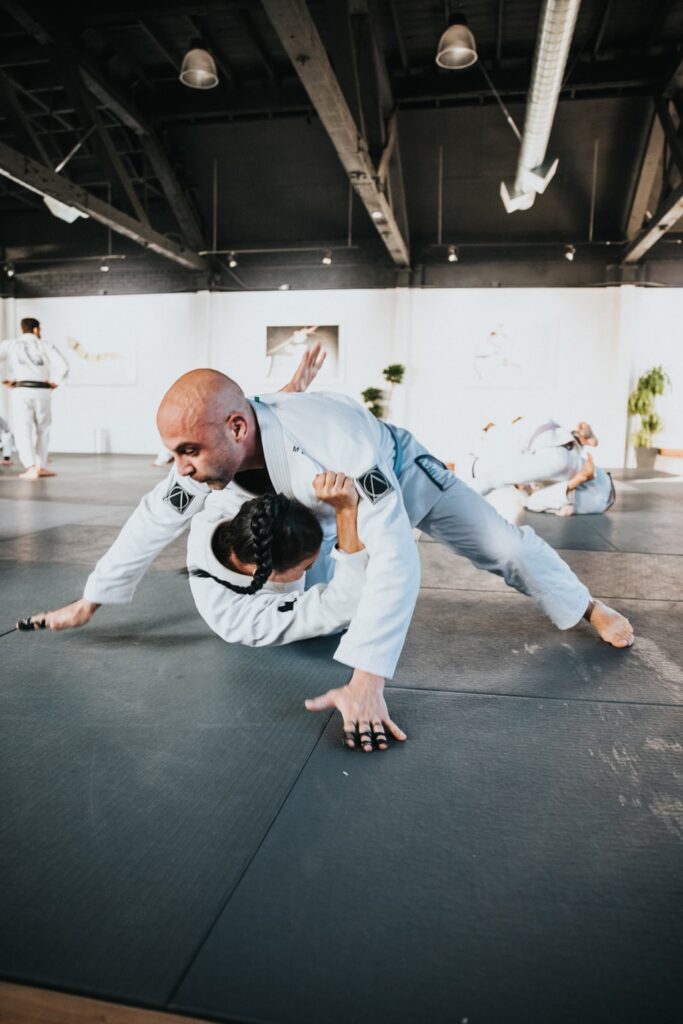
August ended up being a lot of Brazilian jiu-jitsu for me. Schedules and events conspired to allow me to put in some extra time on the mat, and I was reminded of a couple important lessons from BJJ that are applicable not just to sparring in the gym for sport, but to fighting for your life against an attacker.
We’ve talked before about how BJJ can be a route to learning how to get comfortable with being uncomfortable. It’s difficult for me to overemphasize the importance of that concept. When you cannot revel in discomfort, you will shut down and you will panic, so that it becomes impossible for you to find a way to struggle towards triumph. Calm may seem too much to ask for, but it is possible. It’s not that you need to experience every bad circumstance possible so that you can earn the realization that it is survivable – a sampling will do. The more you do it, though, the more you’ll remove the novelty of being in a poor position. When it’s not distressingly unusual anymore, then you’ll stop being busy with your fear and start having the space to breathe and to strategize your next move.
For example, while getting stuck in bottom side control is awfully common, especially (but not only) for people new to BJJ, each experience of it is just a little bit different. Yes, the basic idea of being on your back or side with someone lying on top of and somewhat perpendicular to you doesn’t change, but the details do. Sometimes the guy on top is bigger or heavier, or their weight is centered on your chest instead of lower on your abdomen. Sometimes you feel crushed so much under their body that you can barely breathe. Sometimes, it’s feels like a cage of fast-moving limbs instead. Over time, you’ll discover that they may feel unalike but that there are more similarities than not. It’s like that with getting comfortable inside poor circumstances of any kind. At some point, your initial feelings and reactions will be the same enough, and your faith that you can persevere and survive will be strong enough, that you will be able to put aside the worry and proceed with the work of actually getting through the thing.
The other lesson of bottom side control is that you need to always struggle to improve your position. It might be incremental shifts, fractions of an inch to get your hands and arms to a better place, to put your feet more solidly on the ground, all so that you are ready to explode when the opportunity presents itself to escape or to turn the tables on your opponent. It might be pushing to turn your body or lift your hips, as hard as you can, over and over until you’ve unbalanced your opponent or forced them to give you enough space between your body and theirs that you can press a more active defense or even an attack. It may be reaching out and grabbing a limb with your hand or catching it with your flexed foot. Which one? At first, you’ll try whatever you know and that your overwhelmed mind and body can come up with. Over time, the position will start to look familiar enough that you can pick and choose for the best effect.
When it comes to self-defense, the skills might be directly applicable…or they might not. The attack might come from further away, or by a different avenue. It may be more subtle than someone throwing their body on yours in an attempt to harm you. The principles remain the same regardless: keep working towards a resolution in your favor; always be ready to take advantage of openings. You might have to try a variety of techniques and tools, perhaps cycling through several and going back to some again and again. Not everything you know will work under all conditions, and you might not know right away if this is the one that will break you free. Then even if it doesn’t work the first time, some subtle change between now and a few moments from now might mean that it will work next time. Maybe you’ll be able to put in that little extra oomph of effort. Maybe your attacker will be worn down from what you’ve tried before. Maybe your timing is finally perfect, taking full advantage of a moment of indecision or weakness.
I won’t say that you won’t know until you try, because that’s not always true. Some strategies have a higher percentage of success than others. You can learn which ones do through paying attention to trustworthy sources, through sharpening your skills against realistic standards, and through training against people who are determined to win their mock encounter against you. Each of those will guide you to the techniques and tools that will be most likely to work in your hands. More importantly, they’ll help you understand what you need to do to make them work as well as possible, and make it possible for you to do it more perfectly. That’s because just knowing what might be an effective defense in theory isn’t enough; you need to study the various options and try them out – in person or by proxy – to ensure that they hold up in reality. You can’t rely only on that knowledge either, because in practice they might not be so reliable unless you put in the work to learn how to apply that knowledge against an actual danger.
BJJ is my tool for experiencing discomfort enough to be able to manage it and find ways out of it. Through this sport, I have learned not to quit, to keep struggling until the fight is over, by submission or by the rescue of the bell sounding the end of a round. I have been trapped under bodies and tapped to submissions, only to be let free because the fight wasn’t yet ended. It’s not the only way to gain these experiences, though. You can find your own, but look for those qualities so that you, too, can learn to survive the unsurvivable, confront the implacable, and win against the unbeatable.




